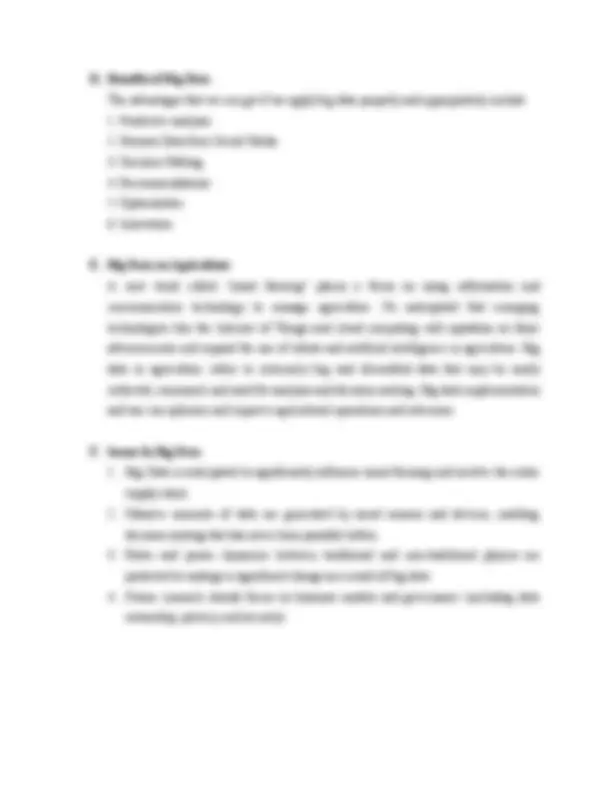



Study with the several resources on Docsity

Earn points by helping other students or get them with a premium plan


Prepare for your exams
Study with the several resources on Docsity

Earn points to download
Earn points by helping other students or get them with a premium plan
Community
Ask the community for help and clear up your study doubts
Discover the best universities in your country according to Docsity users
Free resources
Download our free guides on studying techniques, anxiety management strategies, and thesis advice from Docsity tutors
This document explain about What is Big Data, Source of Big Data, Example Use of Big Data, Benefits of Big Data, Big Data on Agriculture, and Issues In Big Data
Typology: Lecture notes
1 / 3

This page cannot be seen from the preview
Don't miss anything!


A. What is Big Data? Information and computer technology are divided into several major fields, such as computer science, computer engineering, software engineering, and artificial intelligence. Then the major fields are further divided into two sub-fields, namely databases and computer networks. This database discusses data. Data is everything that exists and can be recorded so that later it can be used or utilized. Data must be collected first and then processed with certain techniques so that it can be understood by everyone. This processed data can be used as interesting information. Data can be in the form of text, files, video images, voice recordings, and others. Furthermore, there is the term database (database), which is a place to store data so that data can be more organized and neatly stored in a structured manner so that if you want to use it in the future, the data can be retrieved or searched easily and analyzed. There are various types of databases, namely structured, semi-structured, and not structured at all. In addition to data and databases, there is also such a thing as big data. Big data is a term to describe large volumes of variable data at high speed and complexity, which requires advanced techniques and technologies to enable the retrieval, storage, distribution, management, and analysis of information. This very large amount of data is to be analyzed so that it becomes information so that later the information can become knowledge. This knowledge is used for decision making or making. In big data itself, there are three characteristics or aspects which are usually referred to as 3V. 3V itself consists of volume, velocity, and variety. Here's the explanation:
1. Volume The name "big data" itself means data of a large size, therefore the size of the data itself has an important role. A data set can be categorized as big data or not depending on the volume of data.
2. Velocity Velocity is the speed of data—how fast data can be generated and how fast data can be processed and analyzed to meet a need. In addition to data collection, which must be fast, the speed of data transfer is also very influential, especially in the process of sending data. If big data has a speed that allows it, then the data can be received or used directly (in real time). 3. Variety Variety is defined as the variety of data types owned by big data. Usually, traditional data types are more structured, but as big data develops, there is a lot of new data in the form of unstructured (unstructured) and semi-structured (semi-structured) data. B. Source of Big Data There are various sources of big data, namely: